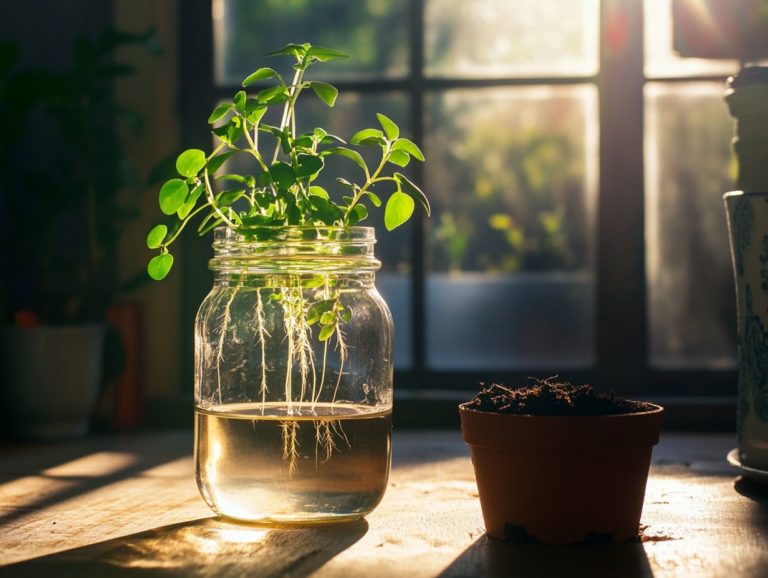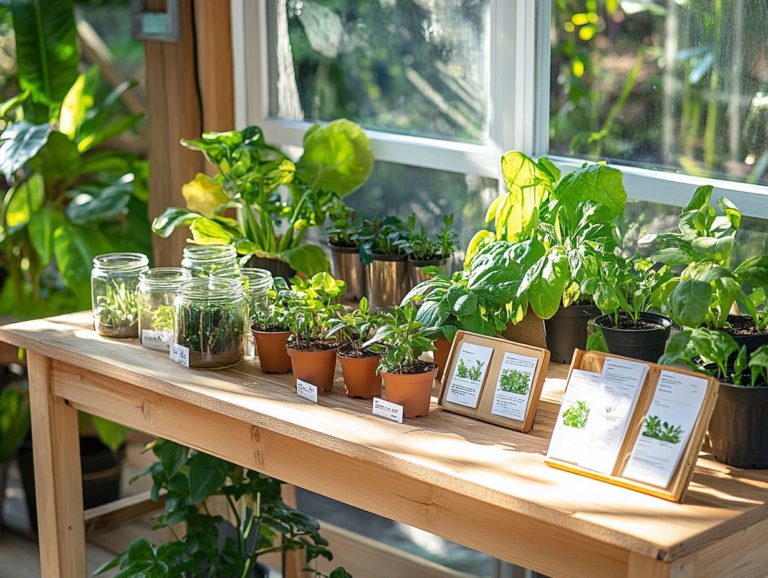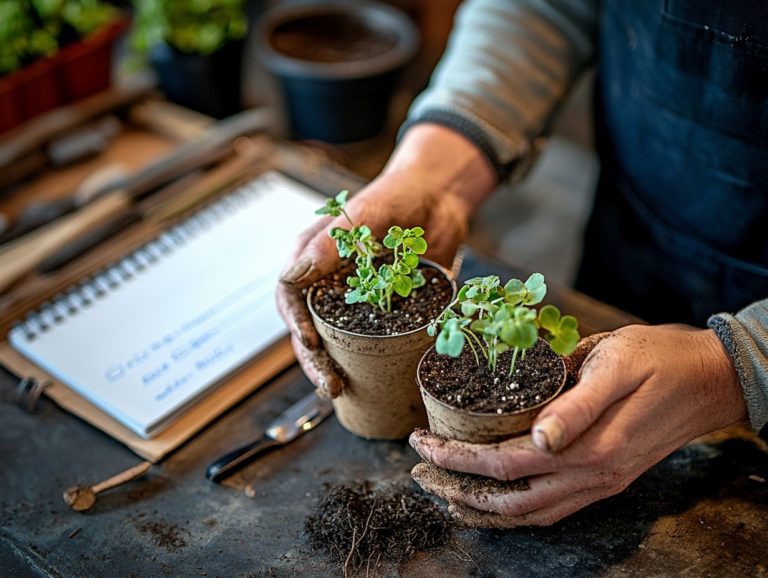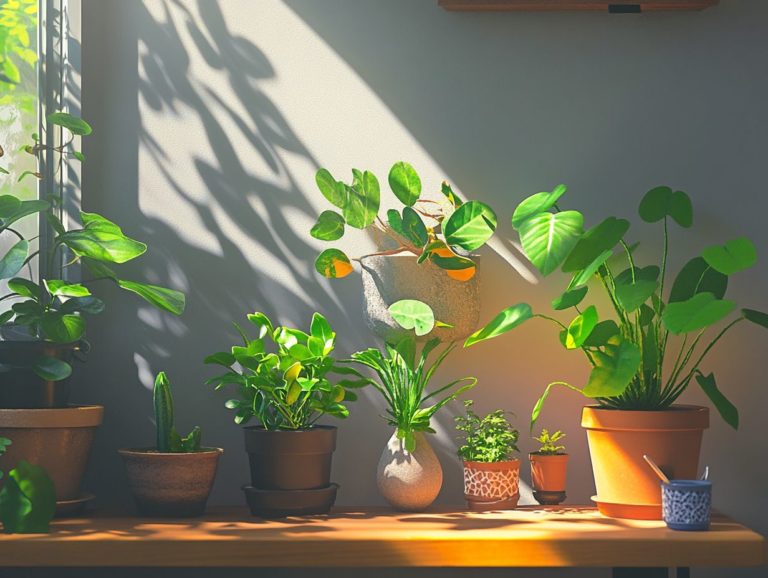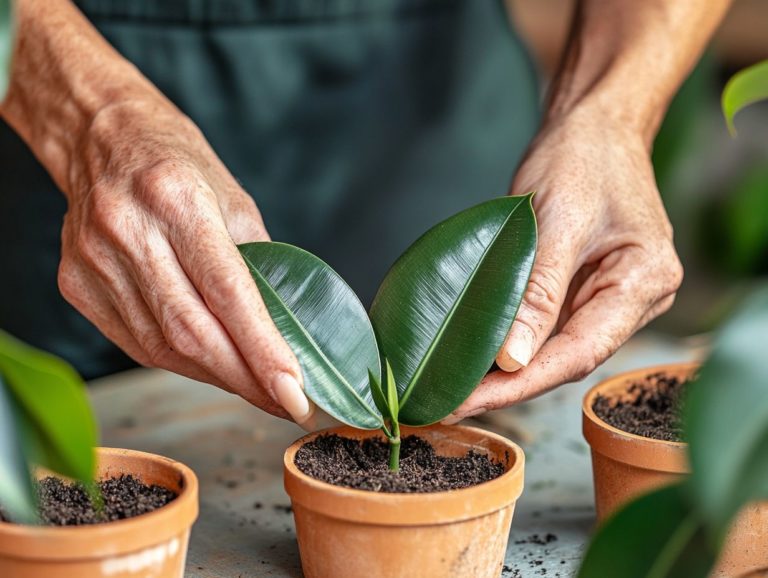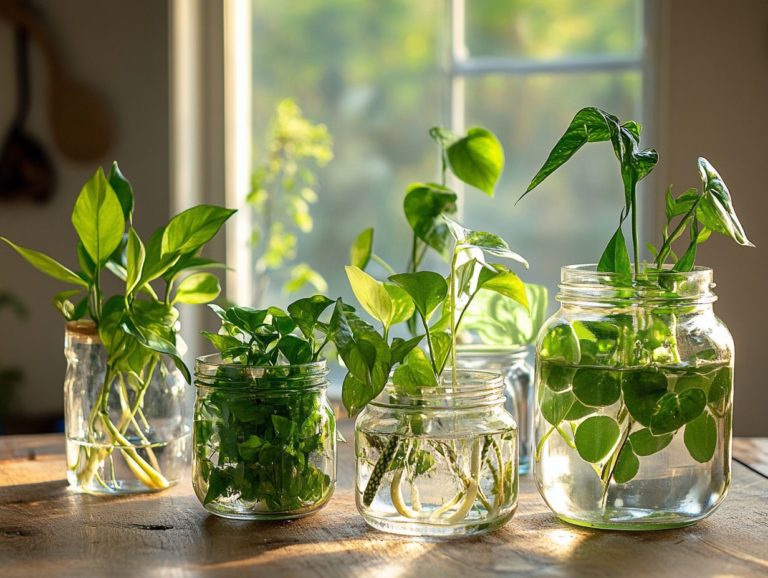5 Best Indoor Plants for Beginners to Propagate
Are you eager to introduce a refreshing touch of greenery into your home without the hassle of complicated care routines? Embracing indoor plants can be a truly rewarding endeavor, especially once you master the art of propagation the process of creating new plants from cuttings of existing ones.
Get ready to explore five fantastic indoor plants that are perfect for beginners, featuring the vibrant Spider Plant and the effortlessly low-maintenance Pothos. You’ll discover the essentials of propagation, including crucial steps, optimal conditions, common pitfalls to avoid, and various methods to try.
Prepare to cultivate your indoor jungle and revel in the myriad benefits of plant propagation!
Contents
- Key Takeaways:
- 1. Spider Plant
- 2. Pothos
- 3. Snake Plant
- 4. Succulents
- 5. Chinese Money Plant
- What Is Propagation and Why Is It Beneficial for Indoor Plants?
- What Are the Basic Steps for Propagating Indoor Plants?
- What Are the Best Conditions for Propagating Indoor Plants?
- What Are the Common Mistakes to Avoid When Propagating Indoor Plants?
- How Can Propagation Help in Plant Care and Maintenance?
- What Are the Different Methods of Propagation for Indoor Plants?
- Frequently Asked Questions
Key Takeaways:
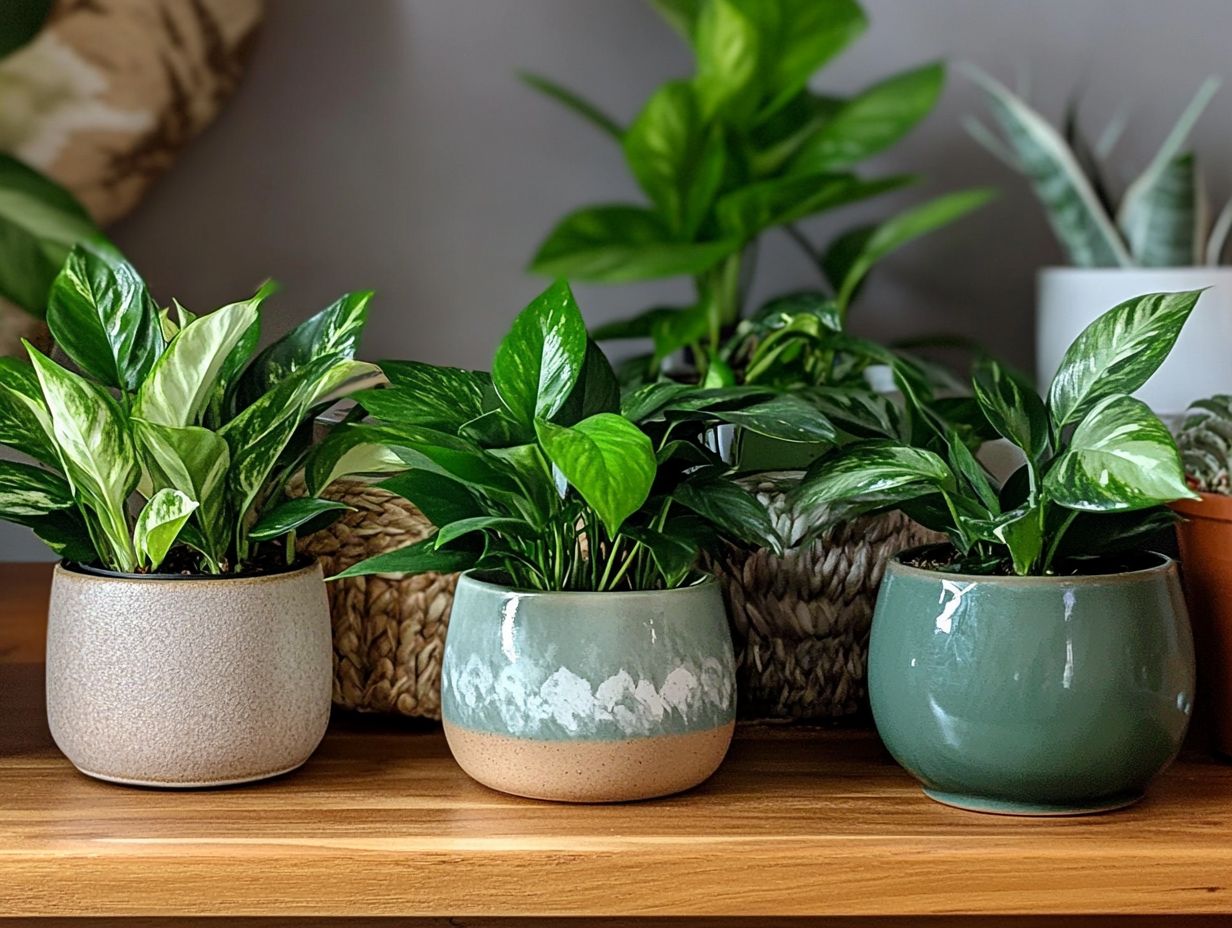
- Propagation creates new plants from existing ones, helping indoor plants grow and thrive.
- Creating new plants is easy and requires selecting a healthy parent plant, preparing suitable soil, and providing proper lighting and temperature.
- Avoid common mistakes during propagation, such as overwatering or using the wrong soil type, to ensure success.
1. Spider Plant
The Spider Plant, scientifically known as Chlorophytum comosum, is one of the easiest houseplants to care for, making it a top choice whether you re a beginner or a seasoned indoor gardener. This versatile plant not only enhances the beauty of your living space but also purifies the air, enriching your indoor environment.
With its long, arching leaves and charming ability to produce ‘plant babies‘ or offshoots, the Spider Plant thrives in a variety of conditions, making it an incredibly resilient choice for your home. Jo Lambell, a well-respected gardening expert, often highlights its low maintenance and exceptional versatility in her plant care advice.
Beyond its aesthetic allure, the Spider Plant showcases remarkable growth habits. It adapts effortlessly to different light levels while favoring bright, indirect sunlight. To keep it in optimal health, regular watering is essential, but be sure to allow the soil to dry slightly between sessions to prevent root rot.
Propagating this easy-care plant can be a delightful experience. Simply cut the offshoots and place them in soil to witness new growth. With these outstanding qualities, the Spider Plant fits seamlessly into any indoor garden, especially when paired with the top 5 indoor plants for east-facing windows, enhancing both beauty and air quality.
2. Pothos
Pothos, often called Devil’s Ivy, is your go-to houseplant if you re looking for something easy to grow. This hardy vine boasts striking heart-shaped leaves that thrive in various lighting conditions, whether in low light or bright indirect sunlight.
Not only does Pothos elevate the aesthetic of your space, but its air-purifying qualities also enhance the overall health of your indoor environment. With minimal care, this resilient plant can flourish and produce long, trailing stems, effortlessly adding a touch of nature to any room.
If you re thinking about incorporating this versatile gem into your collection, remember that it thrives in well-draining soil and prefers to be watered only when the top inch of soil is dry; too much moisture can lead to root rot. Pothos is adaptable to various humidity levels, making it a perfect fit for diverse indoor settings.
For those intrigued by propagation, it s a breeze simply cut a healthy vine just below a leaf node and place it in water until roots develop, usually within a few weeks. With just a little attention and care, this plant can flourish, creating a lush and welcoming atmosphere in your living space.
Start your indoor gardening adventure today and watch your space come alive with greenery!
3. Snake Plant
The Snake Plant, or Sansevieria, is a true gem in the world of houseplants, renowned for its stunning look and remarkable resilience. It s one of the easiest plants to care for, effortlessly fitting into any indoor garden!
You ll be captivated by its upright, sword-like leaves, which can boast colors ranging from deep green to beautiful variegated patterns. This adds a sleek, modern flair to your decor.
It s also an air-purifying powerhouse. The Snake Plant thrives even in low light with minimal watering perfect for anyone seeking a low-maintenance green companion!
Not only does the Snake Plant elevate your space aesthetically, but it also fosters a healthier home environment.
This plant shines when it comes to converting carbon dioxide into oxygen, particularly at night. It s an excellent choice for bedrooms or cozy living areas.
Propagating it is a breeze; whether you choose division or leaf cuttings (the process of creating new plants from existing ones), expanding your indoor jungle is simple and satisfying.
Its adaptability has made it a favorite for both seasoned plant lovers and newcomers to gardening.
Known for its durability, the Snake Plant can handle neglect and dry conditions with ease. Here s a bonus: it s non-toxic to pets, a significant perk for animal lovers!
Ultimately, this plant enhances both your decor and air quality, making it an ideal companion for any indoor setting.
4. Succulents
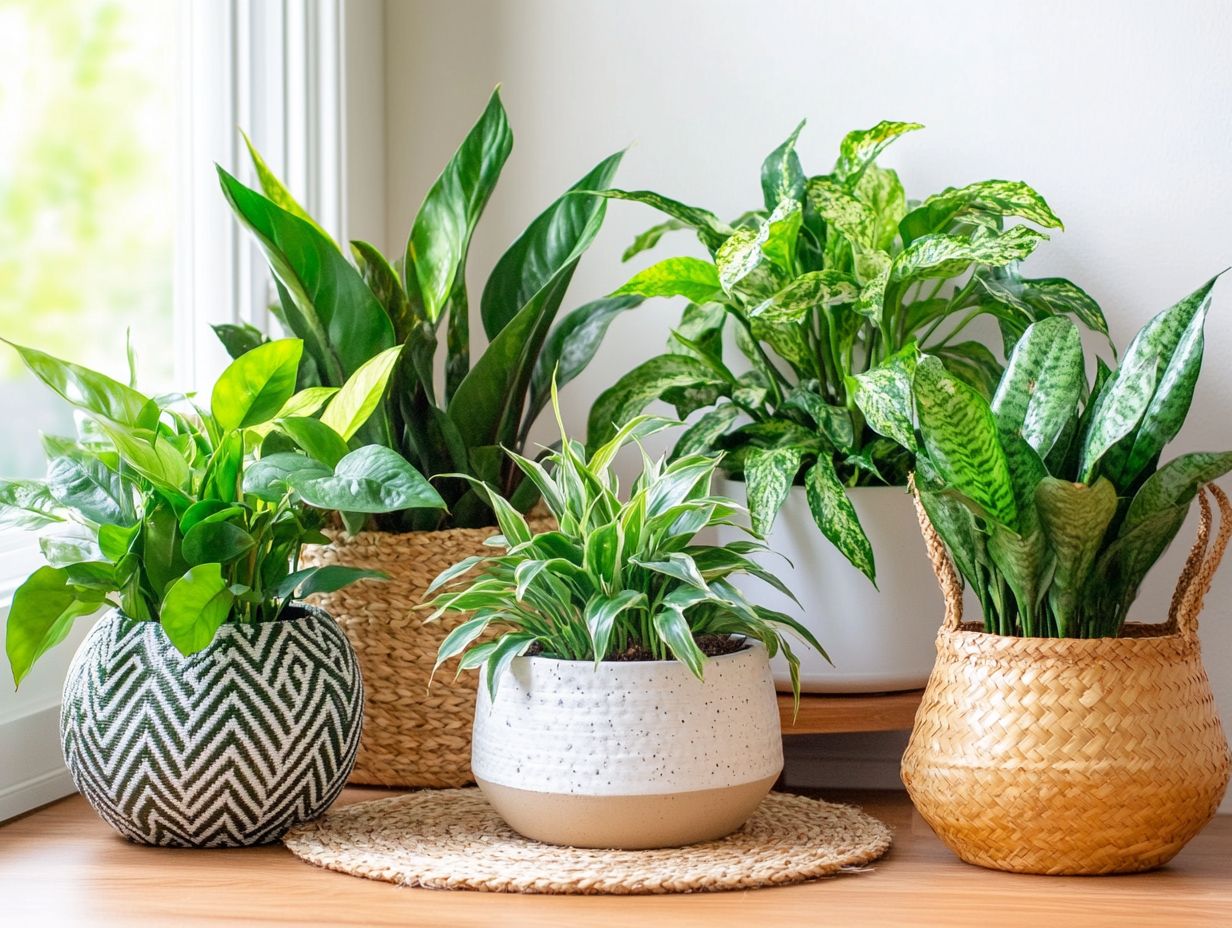
Succulents have become the go-to choice for anyone looking to cultivate houseplants with ease! Their remarkable ability to store water in their leaves makes them perfect for your busy lifestyle.
With a stunning array of shapes, sizes, and colors, succulents bring a vibrant aesthetic to your indoor garden without demanding much in terms of care.
They thrive in well-draining potting soil and need only a few hours of sunlight each day, making them ideal for spaces with limited light.
Their low maintenance and impressive resilience make them suitable for both novices and seasoned plant enthusiasts!
The diversity among succulents is nothing short of remarkable. From the elegant Echeveria to the gorgeous Aloe Vera that instantly brightens your space, each variety brings its own unique charm to your collection.
These plants require water only once every two weeks just keep an eye on the soil moisture to avoid root rot.
Positioning them on windowsills or in areas that receive bright, indirect sunlight can help them truly flourish!
Propagation adds an exciting dimension to your gardening experience. Many succulents can be easily grown from leaf cuttings. This enhances your indoor garden and amplifies the joy of nurturing these delightful plants!
5. Chinese Money Plant
The Chinese Money Plant, or Pilea peperomioides, is a delightful and trendy addition to your indoor garden. It s renowned for its round, coin-like leaves that are said to attract good fortune!
This charming houseplant is incredibly easy to care for; it thrives in bright, indirect light and prefers well-draining potting soil, making it an excellent fit for a variety of indoor spaces.
Its compact size and unique aesthetic will certainly capture the attention of any plant lover eager to enhance their vibrant collection.
With the right care, your Chinese Money Plant can produce numerous offsets (small baby plants that grow from the main plant), giving you the perfect opportunity to propagate and share this delightful gem with friends and family.
What truly sets it apart is not just its visual appeal but also its symbolism of prosperity and positivity, elevating the ambiance of any room.
Gardening enthusiasts often admire its resilience and adaptability, making it the ideal choice for beginners!
Propagation is easy; simply separate the baby plants from the mother and replant them. This invites the joy of nurturing new life into your space!
As a popular choice for indoor gardens, the Chinese Money Plant has secured its place in countless collections, often serving as a catalyst for engaging conversations and connections among fellow plant aficionados.
What Is Propagation and Why Is It Beneficial for Indoor Plants?
Propagation is the process of making new plants from existing ones! It s an essential practice for you as an indoor gardener who wants to expand your collection or introduce charming ‘plant babies’ into your space.
This technique not only allows you to multiply your plant stock but also fosters a healthier life cycle for your greens. Many varieties genuinely flourish when propagated. You ll find common methods like water propagation and soil propagation, each offering distinct advantages depending on the type of plant you re working with.
By embracing the benefits of propagation, you can enhance your plant care routine and revel in the gratifying experience of nurturing new growth!
For those who truly cherish indoor gardening, mastering these techniques can cultivate a deeper sense of community. Sharing cuttings or rooted plants strengthens bonds among fellow gardening aficionados.
Water propagation shines particularly for certain succulents and delicate varieties, making it easy for you to monitor root growth. Soil propagation works best for sturdier plants like pothos or snake plants, which thrive when directly nestled into their new homes. If you’re looking for options that flourish in low light, consider the top 5 shade-tolerant indoor plants.
By engaging in these methods, not only do you create a vibrant green environment, but you also champion sustainable practices! Propagating plants cuts down on the need for commercial purchases. This thoughtful approach to plant care enriches both your gardening skills and the flourishing lives of your leafy companions.
What Are the Basic Steps for Propagating Indoor Plants?
The basic steps for propagating indoor plants involve several key processes that ensure your ‘plant babies’ thrive beautifully in your indoor garden.
- Start by selecting a healthy plant and determining the appropriate cutting methods (pieces of the plant).
- Once you’ve obtained your cuttings, place them in water or potting soil, ensuring they receive adequate sunlight and humidity for optimal rooting.
- Keep a close eye on moisture levels, meaning keeping the soil or water at the right wetness, and adjust your watering routine as needed. This creates a nurturing environment for those new roots to flourish.
It’s essential to select cuttings that are free from pests or diseases, as this directly impacts your success in propagation. After preparing the cuttings, opt for a well-draining potting mix that allows for good air circulation, promoting robust root development. For bright spaces, consider incorporating the top 5 indoor plants that thrive in such conditions.
Position your cuttings to receive bright, indirect light steering clear of harsh exposure that could stress them out.
Maintaining a consistent humidity level is key to nurturing the cuttings and preventing wilting.
By diligently following these steps, you not only foster healthier plants but also enhance the joy of cultivating your indoor botanical collection!
What Are the Best Conditions for Propagating Indoor Plants?
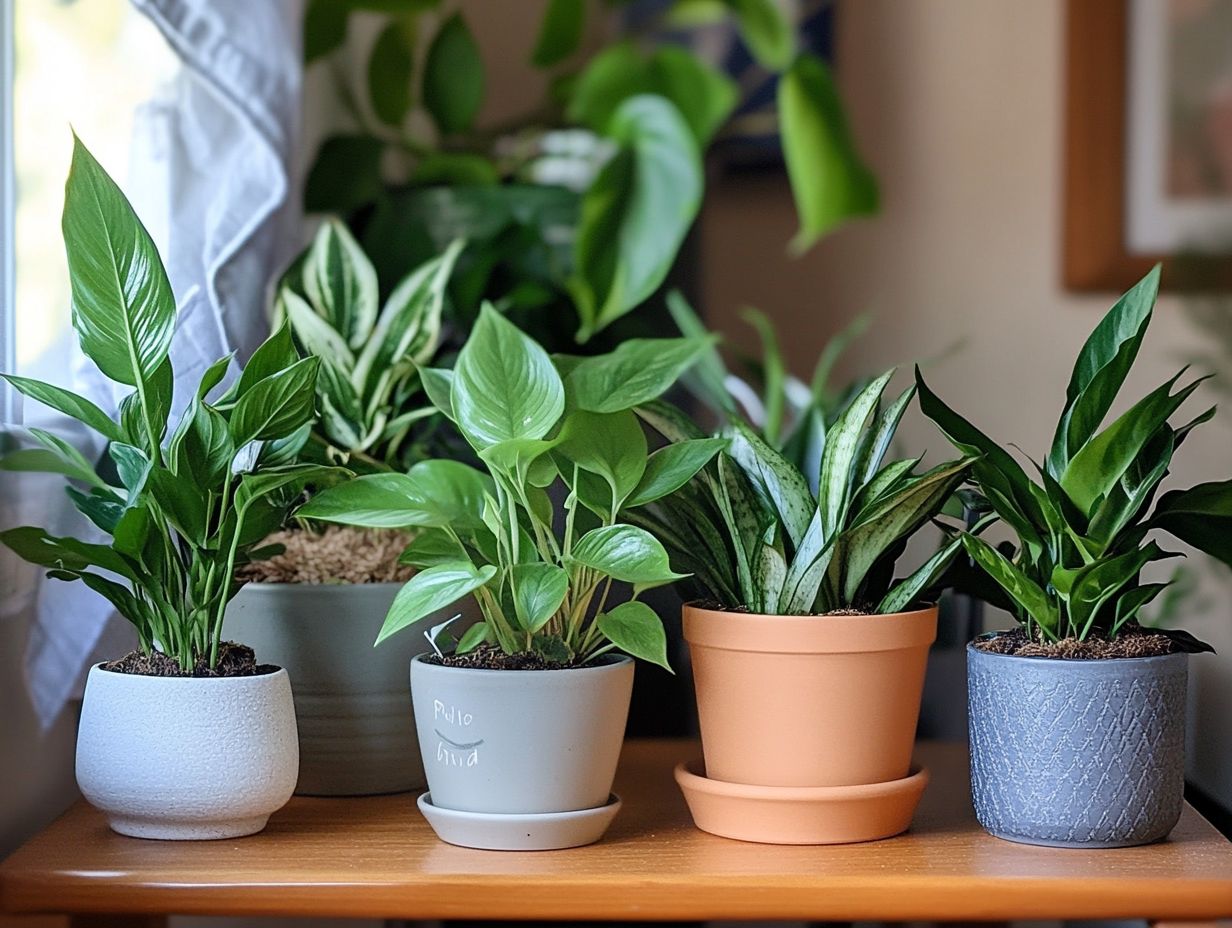
Creating the ideal environment for propagating indoor plants is crucial! It ensures the successful growth and development of your new green companions, especially in an indoor garden.
By diligently monitoring environmental factors, you can cultivate a nurturing space that encourages healthy seedlings to thrive. In indoor settings, utilizing grow lights can effectively replicate the bright, indirect light many plants desire, compensating for any shortfall in natural sunlight.
Plus, maintaining a cozy ambient temperature between 65 F and 75 F promotes safe root development. Keeping humidity levels elevated, ideally around 50% to 70%, fosters an environment that supports young plants beautifully.
A thoughtfully designed propagation station not only provides the perfect conditions but also acts as your dedicated space to track growth, ensuring that each cutting receives the optimal care it needs to flourish.
Start propagating your plants today!
What Are the Common Mistakes to Avoid When Propagating Indoor Plants?
When propagating indoor plants, steering clear of common mistakes is essential. This ensures your cuttings blossom into thriving new plants.
One frequent error is over-watering. Too much moisture can lead to rot, while insufficient light can hinder growth.
Choosing the wrong potting soil, which is the soil used to grow plants in pots, can also hinder rooting, so it s vital to select the appropriate medium for each plant species.
Identifying and addressing these pitfalls helps you enhance your propagation success and enjoy a flourishing indoor garden.
To further elevate your efforts, consider keeping an eye on the humidity levels in your environment. Low humidity can dry out cuttings, while high humidity might invite fungal issues.
Use a well-draining potting mix designed for your plants to help them thrive. A blend that incorporates perlite or vermiculite can improve aeration.
Positioning cuttings in a spot with bright, indirect sunlight helps prevent leggy growth and ensures that new shoots develop robustly.
How Can Propagation Help in Plant Care and Maintenance?
Propagation is key to your plant care journey! It allows you to rejuvenate your collection and encourage new growth in your indoor garden.
Through this enriching practice, you can not only manage your existing plant populations but also curate a captivating and diverse array of greenery that transforms your living space.
As your plants multiply, they introduce layers of texture and color, enhancing the overall atmosphere of your environment.
Engaging in propagation offers substantial economic savings, sparing you from frequent nursery trips and fostering a more sustainable approach to your gardening endeavors.
Growing plants from cuttings or seeds deepens your connection to the gardening process, enriching your experience and knowledge of plant care while simultaneously supporting your mental well-being and the indoor ecosystem.
What Are the Different Methods of Propagation for Indoor Plants?
There are numerous methods for propagating indoor plants, each tailored to various plant types and your personal gardening style, ensuring the successful growth and expansion of your collection.
For example, water propagation is particularly effective for leafy plants like pothos and philodendrons. This method lets you see the roots grow how cool is that!
Conversely, soil propagation is the go-to for succulents and cacti, which flourish in drier environments; too much water can lead to rot.
Specialized techniques, such as division, work wonders for clumping plants like snake plants, while leaf propagation, often used with succulents, can produce delightful surprises.
By mastering these methods, you can significantly enrich your indoor gardening experience and foster vibrant plant health.
Frequently Asked Questions
Got questions about propagating plants? Here are some common queries that can help you get started!

1. What are the 5 Best Indoor Plants for Beginners to propagate?
The 5 best indoor plants for beginners to propagate are snake plant, pothos, spider plant, succulents, and philodendron. These plants are easy to care for and propagate, making them perfect for beginners.
2. How do I propagate a snake plant?
To propagate a snake plant, simply cut off a healthy leaf near the base and place it in a jar of water. Within a few weeks, you will see roots starting to grow from the bottom of the leaf. Once the roots are at least two inches long, you can transfer the leaf into a pot with soil.
3. Can I propagate succulents from leaves?
Yes, succulents can be propagated from leaves. Simply pluck off a healthy leaf and let it dry for a few days. Once calluses form on the bottom of the leaf, place it in a pot with well-draining soil and mist it every few days until it grows roots and a new plant.
4. What is the easiest way to propagate pothos?
The easiest way to propagate pothos is through stem cuttings. Cut a healthy stem just below a node and place it in a jar of water. Once the roots are at least two inches long, it can be transferred into a pot with soil.
5. How long does it take to propagate a spider plant?
Excitingly, propagating a spider plant can take just 2 to 6 weeks depending on your method!
If you propagate through division, it takes up to 6 weeks for new roots to form. However, using plantlets can yield results in as little as 2 weeks.
6. Can I propagate a philodendron with just water?
Yes! You can easily propagate philodendrons in water.
Simply cut a strong piece of the plant just below a node and place it in a jar of water. Make sure the nodes are submerged to encourage root growth.
Once your roots hit two inches, it s time to plant them in soil and watch them thrive!

